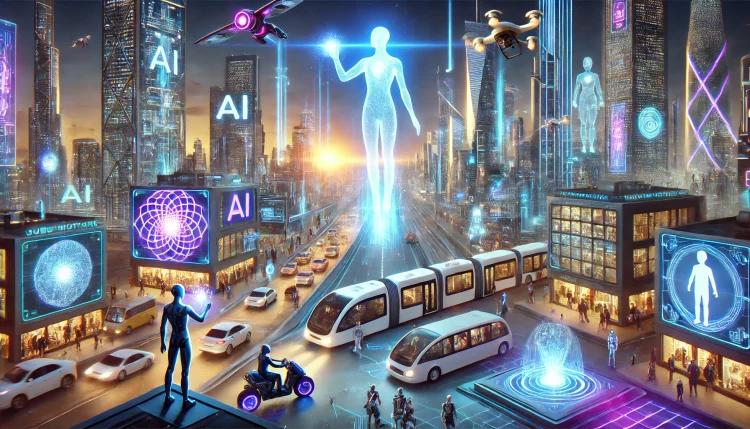Introduction: AI Beyond Convenience
Artificial Intelligence (AI) often evokes images of smart assistants, self-driving cars, and automated workplaces. Yet its potential extends far beyond convenience and commerce. As the world faces unprecedented environmental challenges — climate change, biodiversity loss, pollution, and natural disasters — AI emerges as a powerful ally for planetary stewardship.
Unlike traditional tools, AI can process massive amounts of complex, interconnected data in real time. It can detect patterns invisible to humans, predict outcomes, and optimize systems at scales ranging from local ecosystems to the global climate. In this article, we explore how AI is being harnessed to protect the environment, mitigate disasters, and drive sustainable development.
1. AI for Climate Change Mitigation
Climate change is arguably the greatest challenge of our era, and AI offers multiple ways to tackle it.
1.1 Predictive Climate Modeling
Climate systems are complex and nonlinear, involving atmospheric, oceanic, and terrestrial interactions. Traditional models struggle with uncertainty, but AI-enhanced models can assimilate vast datasets — satellite imagery, historical weather records, and sensor networks — to improve predictions.
For example, AI algorithms now forecast extreme weather events such as hurricanes, heatwaves, and floods with greater accuracy. Governments and organizations use these predictions to allocate resources, plan evacuations, and design adaptive infrastructure.
1.2 Renewable Energy Optimization
Renewable energy sources like solar and wind are inherently variable. AI helps predict energy output, optimize grid integration, and reduce waste. Smart energy grids, powered by machine learning, balance supply and demand dynamically, reducing reliance on fossil fuels.
Companies such as Google DeepMind have used AI to increase the efficiency of wind farms by predicting wind patterns and adjusting turbine operations, demonstrating measurable reductions in carbon emissions.
1.3 Carbon Footprint Reduction
AI analyzes industrial processes, transportation networks, and supply chains to identify opportunities for emission reduction. Logistics companies use AI to optimize delivery routes, minimize fuel consumption, and reduce greenhouse gases. In agriculture, AI-powered monitoring reduces unnecessary fertilizer use, lowering nitrous oxide emissions.
2. Protecting Biodiversity
The planet’s biodiversity is under threat from habitat loss, pollution, and climate change. AI plays a critical role in monitoring, conserving, and restoring ecosystems.
2.1 Wildlife Monitoring
Camera traps and drones generate enormous amounts of visual data. AI algorithms can automatically identify species, track populations, and detect poaching activities. Projects like Wildbook use AI to analyze images of endangered animals, enabling conservationists to take timely action.
2.2 Habitat Mapping
Satellite imagery analyzed by AI helps map ecosystems, monitor deforestation, and detect illegal logging. Machine learning models predict areas at risk, allowing targeted intervention. Organizations such as Global Forest Watch leverage AI to provide near-real-time forest monitoring across continents.
2.3 Predicting Species Extinction
AI models integrate data on species’ distribution, climate conditions, and human activities to forecast extinction risk. These insights guide policymakers in creating effective conservation strategies, prioritizing resources, and designing protected areas.
3. Disaster Response and Management
AI is transforming how humans prepare for and respond to natural and human-made disasters.
3.1 Early Warning Systems
From tsunamis to wildfires, AI predicts disaster occurrence with remarkable speed. By analyzing seismic data, weather patterns, and satellite imagery, AI systems can issue early warnings that save lives. For example, machine learning models predict wildfire outbreaks in California and Australia, enabling faster evacuation and firefighting deployment.
3.2 Resource Allocation
During disasters, AI analyzes logistics, transportation networks, and demand for medical and relief supplies. Organizations use AI to optimize supply chain distribution, ensuring aid reaches affected populations efficiently.
3.3 Crisis Mapping
AI-driven platforms create real-time crisis maps, integrating social media feeds, satellite images, and ground reports. These maps assist first responders and humanitarian organizations in making informed decisions during emergencies.

4. AI in Agriculture: Feeding the Planet Sustainably
Agriculture is both a contributor to and victim of climate change. AI enables precision agriculture, enhancing productivity while minimizing environmental impact.
4.1 Crop Monitoring
AI-powered drones and satellites monitor crop health, detect pests, and assess water needs. By identifying issues early, farmers can reduce pesticide use and increase yield.
4.2 Soil and Water Management
Machine learning models predict soil quality and irrigation requirements, optimizing resource usage. This prevents overwatering, reduces runoff, and conserves freshwater.
4.3 Supply Chain Optimization
AI streamlines distribution, reducing food waste. Predictive models match production with demand, minimizing overproduction and lowering greenhouse gas emissions from spoiled crops.
5. Pollution Control and Waste Management
Urbanization and industrialization generate significant waste and pollution. AI addresses these challenges through monitoring, prediction, and automation.
5.1 Air and Water Quality Monitoring
AI processes sensor networks and satellite imagery to detect pollution hotspots. Cities can respond with targeted interventions, such as traffic adjustments or industrial regulation.
5.2 Waste Sorting and Recycling
AI-powered robots and computer vision systems automate waste sorting, improving recycling rates. This reduces landfill use and ensures that valuable materials are recovered efficiently.
5.3 Ocean Cleanup
AI models track ocean debris, guiding autonomous vessels to collect plastic and pollutants. Projects like The Ocean Cleanup integrate AI to optimize removal strategies, maximizing environmental impact.
6. Urban Sustainability and Smart Infrastructure
AI enables cities to operate efficiently and sustainably.
6.1 Energy-Efficient Buildings
AI optimizes heating, ventilation, and lighting systems in real time, reducing energy consumption. Smart buildings contribute to lowering urban carbon footprints and improving resident comfort.
6.2 Traffic Emission Reduction
AI-controlled traffic management reduces congestion, vehicle idling, and emissions. Integration with public transportation schedules further decreases environmental impact.
6.3 Urban Planning
AI assists planners in designing sustainable neighborhoods, balancing green spaces, transportation networks, and resource allocation. Simulation tools predict long-term environmental impacts before construction begins.
7. Ethical Considerations
While AI offers substantial environmental benefits, ethical concerns must be addressed.
7.1 Data Privacy
Environmental monitoring requires extensive data collection, including satellite imagery and IoT sensor networks. Ensuring privacy, especially in urban areas, is essential.
7.2 Bias and Accuracy
AI predictions depend on data quality. Inaccurate or biased data can lead to misguided environmental interventions, wasting resources or causing unintended harm.
7.3 Equity in Benefits
AI-driven environmental solutions must be accessible globally, not confined to wealthy nations. Equitable deployment ensures that all regions benefit from climate adaptation and conservation tools.
8. Global Initiatives Leveraging AI
Several international initiatives showcase AI’s potential for environmental good:
- Climate TRACE: Uses AI to track global greenhouse gas emissions in real time.
- Wildlife AI Monitoring: Organizations like WWF apply AI to combat poaching and habitat destruction.
- AI for Disaster Risk Reduction (UNDRR): Supports governments in preparing for climate-related disasters.
These examples illustrate that AI can amplify human efforts, making planetary stewardship more effective and proactive.
9. The Future of AI for Sustainability
The next decade will likely see AI integrated more deeply into environmental management:
- Predictive ecosystem modeling to prevent ecological collapse
- AI-guided renewable energy grids with real-time adaptation
- Global disaster response coordination leveraging AI-powered simulations
- Citizen-engaged AI platforms enabling community-driven environmental actions
AI’s success will depend not only on technology but on policy frameworks, international collaboration, and ethical governance.
Conclusion: Technology as a Force for Good
Artificial Intelligence is more than a tool for efficiency or profit. It is an unprecedented instrument for environmental stewardship. By predicting crises, optimizing resources, and supporting conservation, AI can help humanity address the urgent challenges of our time.
However, the power of AI must be wielded responsibly. Accurate data, ethical oversight, and equitable access are crucial to ensuring AI serves the planet rather than narrow interests.
The potential is immense: AI can help humanity transform from passive observers of environmental decline into active custodians of a sustainable, resilient planet. If applied wisely, it is a technology not just of intelligence, but of hope.











































